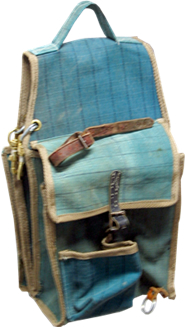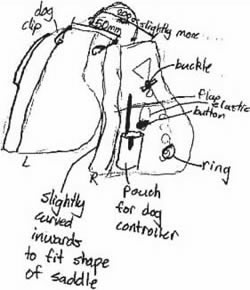Saddlebag for the lambing beat

Maria Henderson
The Correspondence School
Year 11 Technology, half-year project
Teacher: Anna Ponting
Maria's mother gave her an interesting challenge – to make a saddlebag she could use to hold all the gear she needed while riding around the family farm during the lambing season. She set Maria some basic requirements: the bag would have to be easy to carry and attach and detach from the saddle; sit comfortably on the horse without causing any distress; and be easy and safe to use while working with the animals. Maria also established that it needed to be waterproof, robust enough to stand getting knocked about a bit, able to hold all of the equipment she needed for the lambing, and not be too bulky. She also decided the bag would have to be made of readily available materials which were not too costly, and either suited her present skill range or only involved new skills that she could learn within the available timeframe.
After some preliminary research, Maria came up with three different workable concepts and, after discussing their strengths and weakness with her mother, one was chosen to develop through to a final design.
Maria then explored a range of commercially available saddlebags, analysing their attributes in relation to her chosen concept and discussing possible adaptations particularly in terms of the way her bag should be attached to the saddle. She also interviewed a local saddle maker who constructed saddlebags similar to her design, and he gave her valuable advice on material choice and the tools and cutting methods she should be considering.
After further consultation with her mother, including checking the measurements of her hand to make sure she could access the pockets successfully, Maria made some refinements to the performance specifications in the brief, finalised her design and drew out a plan on the computer. Maria used this plan to develop a model of her saddlebag, which she was then able to test out on the horse before making some further refinements to her design.
Maria then made contact with a local canvas maker, Harry, to investigate the use of canvas as the main material for her saddlebag. He proved to be a rich source of information, advising that she change the way she had cut her material for the model and suggesting that she top-sew the material and fold it in a way that would stop rain water from running into the stitching. Maria readily accepted this advice and made adjustments to her pattern and also thought about using eyelets rather than rivets. At this stage she also considered the merits of sewing on a leather strap to hold the saddlebag onto the horse and took up his offer to let her use his machinery to help with the sewing.
Further design changes were made to provide more seam allowance and make the sewing easier, and minor adjustments made to the size of the pockets to better fit the material and the equipment they were designed to hold. A final alteration to the plan involved the use of a buckle and leather strap rather than buttons and elastic for the fastening.
When Maria accepted the invitation for a follow-up visit to Harry to discuss her proposed changes, he suggested she make a further model using his machinery to practice her construction technique. This model was again tested on the horse before the final design and performance specifications were confirmed and construction planning began.
Safety issues were identified, assessed and minimised or, where possible, eliminated. With Harry's expert assistance the construction plan was carefully followed and the final prototype produced. The final stage was the handing over to her mother of the finished saddle-bag for evaluation of its effectiveness in doing the job required.
Maria was delighted with the final product. "It's comfortable, practical, and safe," she says, "and the horse isn't worried about it being on there." She was particularly pleased with the way she had been able to use canvas she had recycled from an old horsecover in the construction of the saddlebag and how easy the bag could be attached and detached using the dog clips.
"Mum, my client, thinks the bag is wonderful, and wishes she'd known about it years ago."
Teacher comment
I was impressed with Maria's work because she was prepared to re-visit her work. I learned many things from Maria's approach to Technology. Her journal was a living document and I really felt I had the privilege of walking beside a person on an exciting journey.
Maria was prepared to approach members of the wider community for specialist help which really paid off. It seemed to me they were very pleased to have the opportunity to share their passion for their trade with a young person. This project was a gift to them too.

Drawing of the saddle's early design
The opportunity to see fitness for purpose develop in front of my very eyes was inspiring. This was a truly authentic issue tested in the field where practicality form and function are equally important for the welfare of stock, safety of the user and the on-going business of a working sheep station.
My lasting impression of Maria's practice is one of a strong iterative process using every resource at her disposal from experts to recycled materials in order to develop the best solution from amongst a wide range of ideas.






